Uranium Demand Surges Amid Global Energy Transition Trends

Uranium Market Dynamics Explored
The global search for reliable energy sources has led to a significant uptick in the demand for uranium. Experts predict a sustained growth trajectory in the uranium markets as nations increasingly embrace nuclear energy. Kazakhstan stands out as the world's largest uranium producer, with notable contributions from countries like Canada, Namibia, and Australia.
Global Consumption Patterns Shift
Countries heavily reliant on nuclear energy, such as the United States, China, and France, remain the leading consumers of uranium. For instance, the U.S. consumed approximately 18,050 metric tons of uranium recently, reflecting its dominant position in the market compared to other nations. Despite a global shift towards alternative energy sources, the stability of nuclear energy consumption over the past decade suggests that uranium will continue to be a critical resource in the near future.
Influencing Factors on Uranium Demand
Geopolitical tensions and uncertainties regarding uranium supply are notable themes, as highlighted by industry analysts. The revitalization of nuclear reactors and ongoing construction of new plants contribute to robust demand for uranium. With events from 2023 still echoing within the market, industry experts believe that various factors favor a bullish outlook for the commodity.
Stallion Uranium Corp.'s Recent Developments
Amid this favorable landscape, Stallion Uranium Corp. (TSX-V: STUD) has emerged as a key player by outlining nine high-priority target areas in the Southwestern Athabasca Basin. Their recent exploration efforts have revealed over 600 km of conductive corridors across a vast land package. Such discoveries are pivotal for identifying potential uranium deposits, aiding Stallion in its mission to uncover the next significant find in this prolific region.
Exploration Highlights of Stallion Uranium
The targets identified by Stallion’s team represent the culmination of thorough data analysis from numerous surveys. The company is actively enhancing its exploration programs, prioritizing these sites for drilling and further investigation. CEO Drew Zimmerman emphasized the potential held within their expansive land, which borders some of the industry’s most significant players.
Market Trends and Price Movements
The uranium market witnessed an impressive 88.54% surge in spot prices last year, a trend that doesn’t seem to be slowing down. As demand for nuclear energy continues to grow, the strategic management of the supply chain becomes increasingly crucial. Stallion’s proactive exploration strategy positions it well within a market ripe for investment.
Other Key Industry Insights
Besides Stallion, other notable companies like Mustang Energy Corp. (CSE: MEC) are involved in exciting projects that could reshape the landscape of uranium mining. Mustang’s recent acquisition in the Cluff Lake region signifies a major step towards tapping into high-grade uranium deposits. Such moves amplify excitement in a sector eager for fresh resources.
NexGen Energy's Progress Report
NexGen Energy Ltd. (NYSE: NXE) has also made headlines with new drill programs at the Patterson Corridor East. The summer program has yielded significant results, confirming the area's promise for mineralization, which could drastically influence the company's trajectory in the coming months.
CanAlaska Uranium's Joint Ventures
CanAlaska Uranium Ltd. (OTCQX: CVVUF) is actively working on its Moon Lake South Joint Venture, examining newly identified targets that demonstrate high-grade uranium possibilities. As its exploration budget expands, stakeholders can anticipate an influx of promising developments.
Conclusion
The current state of the uranium market exemplifies a critical intersection of energy demand and mining opportunities. Industry leaders like Stallion Uranium Corp. (NASDAQ: COOT) continue to navigate this promising landscape, demonstrating resilience and ingenuity in the face of global shifts toward sustainable energy.
Frequently Asked Questions
What is driving the demand for uranium?
The demand for uranium is primarily driven by the global need for stable energy sources, particularly as countries look to nuclear energy as a sustainable alternative.
Who are the major uranium producers?
Major uranium producers include Kazakhstan, Canada, Namibia, and Australia, with Kazakhstan leading significantly in production volumes.
What has been the trend in uranium prices?
Uranium prices have shown strong growth, with an increase of over 88% last year, reflecting increasing demand and decreasing supply.
What are Stallion Uranium Corp.'s recent achievements?
Stallion Uranium Corp. has identified nine high-priority target areas in the Southwestern Athabasca Basin, enhancing its exploration efforts in promising regions.
What impact do geopolitical tensions have on uranium supply?
Geopolitical tensions can disrupt supply chains and impact the availability of uranium, thereby influencing prices and market dynamics.
About Investors Hangout
Investors Hangout is a leading online stock forum for financial discussion and learning, offering a wide range of free tools and resources. It draws in traders of all levels, who exchange market knowledge, investigate trading tactics, and keep an eye on industry developments in real time. Featuring financial articles, stock message boards, quotes, charts, company profiles, and live news updates. Through cooperative learning and a wealth of informational resources, it helps users from novices creating their first portfolios to experts honing their techniques. Join Investors Hangout today: https://investorshangout.com/
Disclaimer: The content of this article is solely for general informational purposes only; it does not represent legal, financial, or investment advice. Investors Hangout does not offer financial advice; the author is not a licensed financial advisor. Consult a qualified advisor before making any financial or investment decisions based on this article. The author's interpretation of publicly available data shapes the opinions presented here; as a result, they should not be taken as advice to purchase, sell, or hold any securities mentioned or any other investments. The author does not guarantee the accuracy, completeness, or timeliness of any material, providing it "as is." Information and market conditions may change; past performance is not indicative of future outcomes. If any of the material offered here is inaccurate, please contact us for corrections.